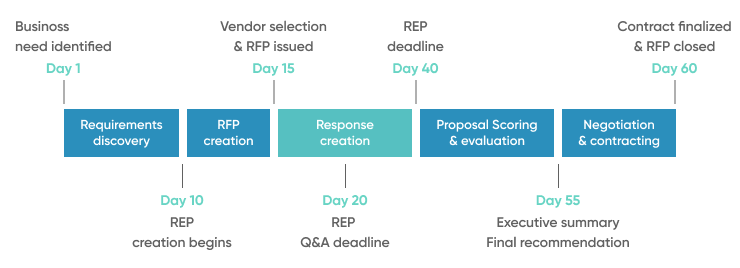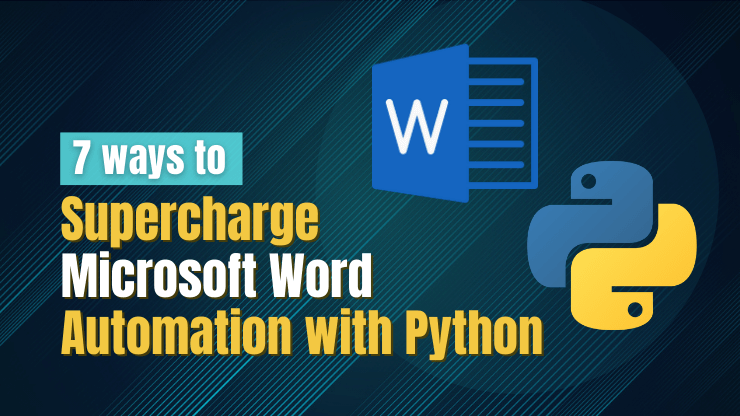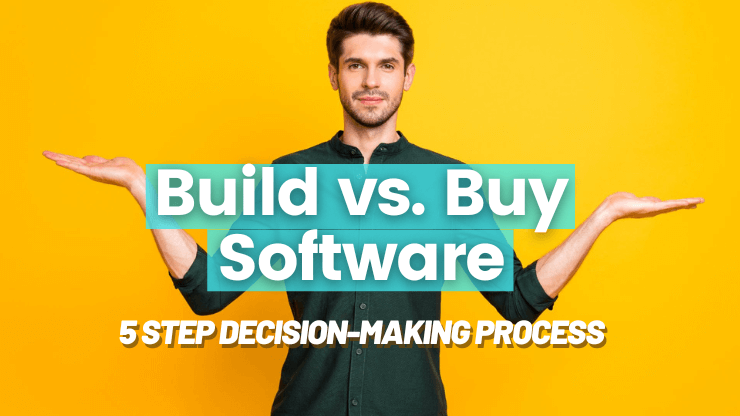Finding the right software development partner for your project can be a complex and time-consuming process. With over 23,000 companies offering custom development services on Clutch.co alone, the sheer number of options can be overwhelming.
One of the best ways to streamline this evaluation and decision making process is to have a quality request for proposal (RFP). The more effective the RFP is in providing key information about your software project to vendors, the more effective the final selection process will be.
To help you put together your own RFP for software development, we’re sharing a step-by-step guide along with a downloadable template. Let’s jump right in!
- What is an RFP for software development?
- Why is an effective RFP important?
- How to Write an Effective Request for Proposal (RFP)
- Step 1: Define project details
- Step 2: Draft the RFP
- Step 3: Issue the RFP
- Step 4: Evaluate proposals and make a decision
- Get software development RFP template (Google Doc)
- Conclusion
What is an RFP for software development?
An RFP for software development is a request for proposal document used to solicit bids from potential vendors for a software project. Typically it contains information such as a project overview, the expected timeline and budget, software requirements, and vendor evaluation and selection criteria to help vendors understand the project scope, so they can deliver a proposal and bid for the work.
Sample RFP for software development timeline

Why is an effective RFP important?
The quality of your RFP document can affect the quality of bids you receive. It important to take the time to put together a detailed and effective RFP, so that you can:
- More easily compare software vendor bids. When you’ve provided a detailed software development RFP to vendors, they’ll be able to deliver a bid that fulfills your proposal requirements and accurately takes into consideration the full project scope.
- Avoid answering endless vendor questions. If you don’t provide a detailed RFP, you’ll be left to answer a long series of questions from vendors or risk vendors simply not having a clear sense for the software development project at hand and providing an inaccurate or incomplete bid.
- Receive more accurate project bids. The more detailed your RFP, the more accurate and detailed the vendors’ bids will be. Vendors need as much information as possible to properly scope out the work required, identify potential risks, and put together an accurate proposal.
How to Write an Effective Request for Proposal (RFP)
A well-written RFP for software development outlines the project’s requirements, budget, timeline, and evaluation criteria, making it easier for a software vendor to produce a comprehensive proposal for the project.
With the right RFP process, you will be able to identify the best fit for your project and ensure that the chosen vendor produces a solution that meets your needs. Let's look closer at each step.
Step 1: Define project details
Don’t jump straight into drafting an RFP or directly requesting bids from vendors without a clear idea of what they’re looking for. This is a mistake. Before drafting a formal RFP, you need to know exactly what you want to build, so that you can accurately articulate it in your RFP document.

So, before even starting to draft your RFP, focus on project planning. Loop in your project management team, product owner, and any other key stakeholders to begin to define the following key project elements of your software project:
Project goals
Work with your stakeholders to establish the project’s goals. Providing this information in your RFP will help give the software development vendor some perspective on what you’re trying to achieve and why.
Key questions to consider:
- What would need to be delivered to consider the project successful?
- How does this project feed into other internal software projects or company objectives?
Stakeholders
Identify the stakeholders who will be involved in the request for proposal process as well as the software project itself. Make note of each person’s roles and responsibilities along with who has decision-making power in the RFP process.
Key questions to consider:
- Who needs to approve the RFP document before it is sent to vendors?
- Who will be involved in the vendor selection process?
- Who will be interfacing with the vendor during and after the vendor selection process?
Budget
Establish a budget for the project. This could be a specific dollar figure, an hourly rate you’re comfortable with, or even a range that you’d like to stay within. Any specific constraints to budget should also be noted, including when payment could be made and in what quarter or fiscal year funds are available.
Key questions to consider:
- Is the budget flexible?
- Are there any limitations as to when the budget can be spent?
- Who must approve the final budget?
Timeline
Establish a timeline for the project. Utilize project management tools to understand project dependencies and staffing availability that could affect your project timeline. Be as detailed as you can at this stage. Any specific timeline constraints could help vendors provide you a more accurate software development project bid.
Key questions to consider:
- What project dependencies should be considered?
- What are the implications if the project deadline is not met?
- Are there milestones that must be met or one single end delivery deadline?
Project requirements
You should have a detailed list of non-functional and functional requirements before proceeding with the RFP process. This is perhaps the most critical piece of project planning if you want to get accurate project bids from each software development company.
Key questions to consider:
- Who needs to be involved in drafting software requirements?
- What is the process for drafting, adding, or removing requirements?
- What diagrams need to be created to support a vendor’s understanding of the requirements?
Scope
Consider what piece of the software development process you’d like the software development company to be involved in. Spell this out specifically, so you can accurately communicate it to vendors in the RFP document.
Key questions to consider:
- Will the scope of the project include UI/UX design?
- Do you need software architecture design support?
- Does the software need to be built from scratch or is only customization or modification work required?
RFP screening process
Unless your company already has an RFP screening process defined for software projects, you need to establish one. Work with your management team or sourcing team to define a specific screening process that’s appropriate for software vendors.
Key questions to consider:
- Is there already an RFP screening process established within your company?
- Who needs to be involved in drafting a new RFP screening process or modifying an existing one?
Selection criteria
Beyond just vendor screening, you should also think about how you will ultimately select the right vendor. You’ll want to provide your vendors a list of specific criteria in your RFP for software development, so that they can tailor their bids to address your priorities.
Key questions to consider:
- Which criteria are most important to you when selecting a vendor?
- What are you willing to compromise on?
PRO TIP: Defining your project’s software requirements is arguably the most critical (and time consuming) piece of the project planning work. While there are many methods for defining software requirements, a Software Requirements Specification (SRS) is a particularly valuable tool for prospective vendors, as it will allow them to create more detailed project bids.
By providing a complete and detailed SRS, vendors can identify the scope of the project and the potential costs involved. An SRS can be attached as an addendum to your RFP and should include:
- Functional requirements (what the system is supposed to do)
- Non-functional requirements (how the system should perform)
- Assumptions and dependencies
- Acceptance criteria
Read More: 7 Key Elements of Effective Software Requirements Specification.
If you need help with drafting Software Requirements Specification (SRS), consider our Software Development Consulting Services.
Step 2: Draft the RFP
With your project planning work complete, you’re now prepared to draft the RFP. You will utilize much of the planning work completed in the previous step to provide your potential vendors with sufficient information about your project. Keep in mind that the more comprehensive and detailed your RFP is, the more accurate the bids will be!

Let’s walk through exactly what should be included in your RFP, starting with the statement of purpose:
Statement of purpose
Explain why you are requesting software development services and, in brief, what you are looking for from vendors.
Company overview
Provide a company description to give vendors some insight into who you are and why you are developing this particular software.
Project goals
Describe the specific goals of the project along with who your end users will be. This will help provide a framework for vendors to understand more details about the project in the coming sections.
Project Goals:
- What do you hope to achieve with this project?
- How will this project fit into your company’s short or long term goals?
Target Audience:
- Who are the end users of your software?
- B2B or B2C audience?
Scope of work
In this section, you should provide more details about the project at hand. The more specific you can be, the more accurate the proposals will be. Start by outlining the scope of the work at a high level, then provide a detailed list of project requirements and specific deliverables. If possible, include how you will measure success for each deliverable.
Work overview: We are looking for a company who can provide the following services:
- What specific UI/UX services are you looking for?
- What project planning and architecture services are you looking for?
- What specific software development services are you looking for?
- What project management support are you looking for?
- What post-launch support services are you looking for?
Requirements:
This is a good place to attach a detailed list of non-functional and functional requirements or a more formal SRS document that outlines your project requirements.
Deliverables:
- What should the IT vendor deliver by project completion?
- How will you measure success?
For related guidance, read:
Budget & contract terms
Even if you don’t have a specific budget, you at least need to provide a range to potential vendors, so they know how to write their proposal. Your budget in combination with your project schedule will dictate if they have the resources to provide what you’re looking for and if not, what compromises you would need to make for them to deliver.
This is also a good place to specify any specific contract terms such as a renewing contract, incentives for completing work early, or penalties for late delivery.
The expected budget for this project is [$X - $X]. This project will be paid [hourly/at the end of project/at the end of every sprint].
Project schedule
Specify if you have a schedule in mind or if you are flexible with when work begins and when the final product is delivered to you. This will help vendors plan the resources they would need to complete the work within the timeframe you are expecting. You can keep it simple and provide a single delivery date or provide several project milestone dates. For example:
| 1 | Project kickoff | [DD/MM/YYYY] |
| 2 | MVP delivered | [DD/MM/YYYY] |
| 3 | Final product delivered | [DD/MM/YYYY] |
Vendor evaluation criteria
Let vendors know what criteria you will be using to evaluate their proposals. This is critical so that vendors can tailor their proposal to meet your expectations and priorities. For example:
| Evaluation criteria | |
| 1 | Proposal returned by deadline of [DD/MM/YYYY] |
| 2 | Pricing and payment terms |
| 3 | Ability to deliver on services requested |
| 4 | Ability to meet project schedule |
| 5 | Experience level of team members |
| 6 | Security and compliance standards |
Requirements for proposals
Specify what you want to see in each proposal. Be as detailed as you can here, as the more similarly structured the bids are, the easier they will be to evaluate and compare. For example:
| Proposal Requirement | |
| 1 | Company name and description |
| 2 | Company location and working hours |
| 3 | Proposed project team along with their qualifications |
| 4 | Estimated project budget |
| 5 | Estimated project start and end date |
| 6 | Project risks |
| 7 | Project proposal in PDF format emailed to [company email] |
RFP process timeline
Provide vendors visibility into the software development request for proposal process timeline, so that they know what to expect after delivering their bid.
| 1 | RFP open | [DD/MM/YYYY] |
| 2 | Bid deadline | [DD/MM/YYYY] |
| 3 | Bid review | [DD/MM/YYYY] |
| 4 | Vendor acceptance notification | [DD/MM/YYYY] |
Contact information
Provide the contact information for the project lead or sourcing manager who will be able to answer vendor questions during the RFP process. This doesn’t necessarily need to be the same person who will lead the project during execution.
[Company Name]
[Name of Point of Contact]
[Email]
[Phone Number]
PRO TIP: Drafting an RFP is a team effort. To keep things on track, create a timeline for each step of the RFP drafting process and set clear deadlines for each team member involved in order to ensure that all tasks are completed in a timely manner.

Step 3: Issue the RFP
Now that you have prepared your RFP, it’s time to issue it to potential vendors on your short list. Here are a few tips how to find software development partner:
- Use Google to search to find the best development companies in a particular geographical area or that specialize in a particular technology. From individual company websites you can get information on their software development services, the skillsets of their web developers, industries they work with, their previous clients and their work processes.
- Browse software development review and rankings websites. One of the most popular of them is Clutch. You can view the search results by location, minimum project size, average hourly rate, industry focus, and more.
- Ask for recommendations from friends and colleagues. Reach out to your contacts to see if anyone has any web development companies they would recommend. This can be a great jumping off point for finding potential options for your own project!
When you’re ready, email your RFP to your short list of software vendors and prepare to answer vendor questions. As you receive proposals, add them to a central repository where every stakeholder can access to help you prepare for the evaluation stage.
PRO TIP: Before you send it out, make sure you have conducted a final review:
- Does your RFP contain a clear RFP process timeline, including a deadline for receiving submissions?
- Does your RFP provide contact information for someone in your organization who will be able to answer questions (or direct questions to the right person)?
- Have all key stakeholders reviewed and approved the RFP?
Step 4: Evaluate proposals and make a decision
Once the deadline has passed, it is time to evaluate the proposals. This process involves assessing the quality of the solutions proposed against the criteria you outlined in the RFP. Depending on the number of proposals you have received, it can be helpful to create a spreadsheet where you can enter key information from each proposal to help you properly compare vendors.
As you're evaluating the proposals, a shortlist of finalists should be selected. From here, it is essential to interview these finalists and check their references. Once the evaluation process is complete and the software development company selection is made, it is time to award the contract. This includes signing a contract, paying any necessary deposits, and setting up an onboarding process, so you can kick off your software project!
PRO TIP: You should establish objective evaluation criteria to ensure you select a vendor based on facts and not feelings. Consider criteria such as:
- Quality of customer references: Are the references verifiable and current? Are the references for clients who had similar software development projects?
- Reputation of vendor: Does the vendor have a proven track record in completing similar software development projects?
- Software features and functionality: Does the proposed implementation plan meet the requirements of the RFP?
- Cost: Does the cost of the software fit within the budget? Do the payment terms match what was included in the software development RFP?
- Integration capabilities: Does the proposed software have the ability to integrate with other systems? Does the vendor have experience implementing similar integrations?
Get software development RFP template (Google Doc)
Ready to download the RFP for software development template for yourself? Get your own copy here!

Conclusion
Creating an effective RFP for software development can help you make an informed decision when selecting a vendor for your project. By taking the time to define project details, draft an RFP, issue the RFP to potential vendors, and evaluate the bids, you can ensure that you receive quality proposals from vendors who understand the full scope of the project and can deliver a successful solution. With the right process, you can have the confidence of knowing that you are selecting the right software development company for your project.
Custom Software Development with SoftKraft
Looking for an outsourcing custom software development company? At SoftKraft we offer custom software development services to help teams build stand-out software products and accelerate business growth. We’ll work closely with you to understand your unique project goals, map out a strategic solution, and build software to your specifications so you can maximize your ROI. At the end of the day, the only metric that matters to us is project success. Get in touch

![Effective RFP for Software Development [Template & Process]](/.netlify/images?url=_astro%2Frfp-for-software+development.DEa5y5TG.png)





